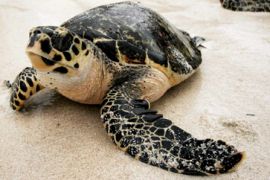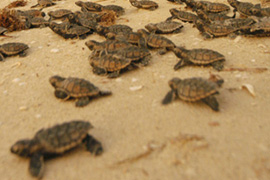Tracking turtles in the Gulf
Construction and economic development threatens the regions already endangered turtles.

A three-year satellite tracking programme has been launched to help identify the migration routes and near-shore habitats favoured by turtles in the Gulf. Five countries are taking part in the marine turtle conservation project – the first of its kind in the region.
In each country five nesting Hawksbill turtles have been fitted with satellite transmitters which will remain active for 400 days. Turtles are increasingly endangered worldwide, and the information yielded by the transmitters should help scientists to make long-term plans for their protection.
Keep reading
list of 4 itemsAre seed-sowing drones the answer to global deforestation?
Rainfall set to help crews battling wildfire near Canada’s Fort McMurray
The Alabama town living and dying in the shadow of chemical plants
Conservation is a growing field and the threats to turtles are many – predators, oil spills and fisherman’s nets. But the rapid loss of beaches due to building and economic development in the Gulf could pose the greatest threat as when they reach sexual maturity turtles return to the beach where they were born to nest.
This is when the female turtles are tagged with satellite trackers, with the aim of learning more about where they go to feed. Twenty-four turtles have been tagged in Iran, Oman, the United Arab Emirates, Saudi Arabia and Qatar and are now sending data to a central database, gulfturtles.com.
The information will be used to better understand the turtles and the dangers they face and there is already some interesting data.
Mehsin Al Ansi from the Environmental Studies Centre at Qatar University is leading the project in Qatar.
“Three or four years back we didn’t have any information, not just in Qatar, all around the region. Before we started our project, we knew that turtles travel for long long distances – and that’s maybe for other species like green turtle or leatherback. But for this species, we see the Hawksbill as a local turtle, so far,” he explains.
Just one turtle has bucked the trend, leaving the Omani coast to travel to the waters of the Gulf.
The Emirates Wildlife Society – World Wildlife Fund (EWS-WWF) organisation in the United Arab Emirates drove the three-year project, along with the Marine Research Foundation based in Malaysia. They plan to eventually tag up to 75 turtles.
Lisa Perry of EWS-WWF explains that the project has been in the pipeline for several years.
“A lot of research has already been done, but it was scattered and fragmented. This is a way to bring the region’s data together,” she says, adding that much of the data that has existed to date has not been made publically available.
Onshore habitat
 |
| The turtles return to the beach where they were born to nest [EPA] |
There is also an increasing need to protect the turtle’s onshore habitat. Fuwairit beach in Qatar is used for motor sports and camping, but now part of it is shut off so that turtles can lay their eggs in peace and to keep the eggs safe until the baby turtles are ready to hatch. In the past they were crushed by four-wheel drives and even stolen for human consumption.
Shafeeq Hamza works for Qatar University and has spent the past three months living on Fuwairit beach to safeguard the turtles.
“There are a lot of improvements,” he says. “When we started a few years back, we’d be here for four or five nights for a single nesting. This year, we had a minimum of three nestings per night and the other day we had six, so that shows how the graph goes up.”
Qatar had 43 three nests in 2010, more than double the amount last year. One nest can have between 50 and 115 eggs, but the survival rate is woeful. Globally, only one in a thousand survive.
The baby turtles born in Qatar this year will not return to lay their first eggs for at least 30 years.
The team from Qatar University have taken pleasure in showing them off to schoolchildren and anyone passing by. They have made a point of inviting schools and local groups to see the hatchings as they believe that educating the public is crucial are hoping to show that conservation should be balanced with development in the Gulf. They hope that beaches like Fuwairit will still be around when the baby turtles are ready to return.